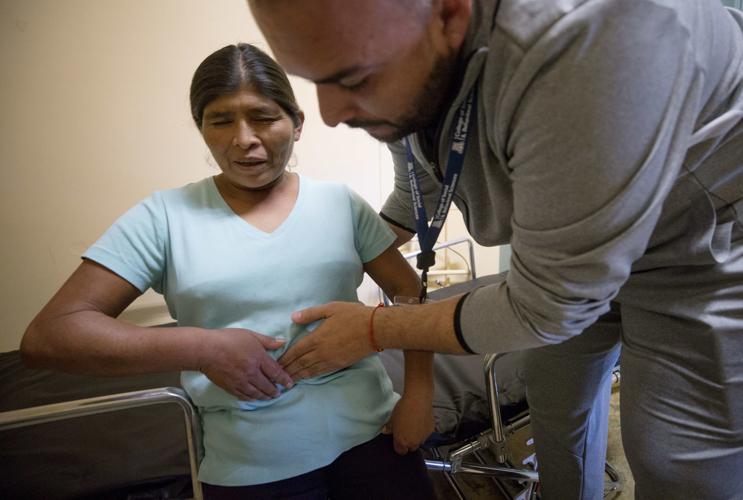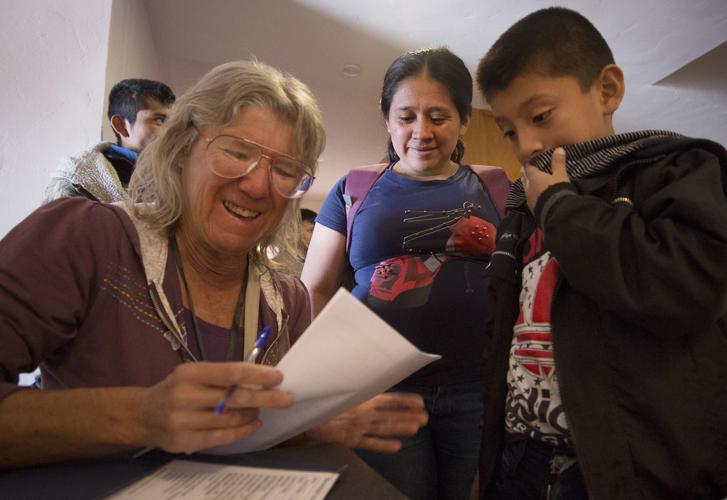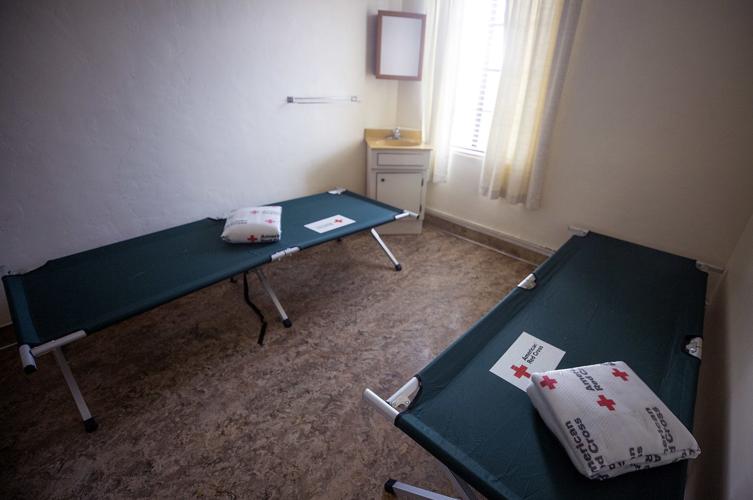Tucson’s iconic Benedictine Monastery opened its doors to Central American asylum seekers ahead of schedule due to larger numbers of families arriving at the border and being released by immigration officials.
Catholic Community Services, which is running the shelter inside the monastery, received the keys on Friday and weren’t planning to open for another two weeks to get the space ready, said Teresa Cavendish, director of operations. But on Saturday, Immigration and Customs Enforcement called them to ask how many people they could take.
“They had 130 who needed to be released,” said Cavendish. The Inn Project, run by the United Methodist Church, could take between 40 and 50, so she told the officials the Casa Alitas network of shelters could take the rest.
The Border Patrol has seen an increase in the number of large groups of 100 immigrants or more apprehended along the southern border in the El Paso, Rio Grande Valley, Tucson and Yuma sectors. During the last four months, the agency said smugglers and traffickers have delivered 53 large groups, totaling 8,797 adults and children.
Within six hours that day, Cavendish said they had the monastery ready and started to receive families vetted by ICE. And it hasn’t stopped.
The owner of the Benedictine Monastery offered to let asylum seekers and migrants stay at the facility while their final destinations are arranged. That’s usually places where they have a close friend or relative who can sponsor them while their immigration cases are processed.
Developer Ross Rulney plans to build apartments around the monastery at 800 N. Country Club Road and has a few more months of rezoning hearings before construction can begin. He offered its use for housing refugees through the end of May since it was empty. Catholic Community Services is the tenant and Rulney is not involved with the operations, nor is he charging rent or receiving any government reimbursement.
So far, Cavendish said, the response by volunteers, which includes medical staff, has been overwhelming. On Saturday afternoon, they quickly helped put together the rooms with cots and blankets, and sorted donated food and clothing in time to receive the first 57 families, mostly from Guatemala.
Between Sunday and Monday, they received another 50. There are a handful of shelters, between houses and churches, that operate in Tucson to house the migrants.
When families arrive they are welcomed by volunteers like Jorge Medina, who is also a paramedic.
“You are not detained anymore, we are volunteers and we are here to help you,” he told a group Monday in Spanish. “It’s my honor and privilege to be able to serve you, please feel at home.”
After the initial intake, families are asked about any health conditions and get medical checks. Dr. Richard Wahl, a pediatrics professor at the University of Arizona who was there this weekend, said most of what they see are mild colds, headaches, stomach aches and dehydration.
“We created our patient and work flow on the spot, but everything worked out surprisingly well,” he said. “It was actually extraordinary how well everything worked out.”
Others have also been working to provide translation to the multiple indigenous-language speakers. Blake Gentry, another volunteer, started recruiting migrants who can help produce videos and drawings of the body, with parts identified in multiple languages to help during the intake process.
The families themselves quickly took charge as well.
Rosa Carrillo, 32, from Guatemala City, volunteered to help with the kitchen, organizing the meals .
“When they first brought us here the first thing that came to my mind was that they were bringing us to another detention,” she said. Carrillo and her 12-year-old son crossed the border Thursday and were held in several Border Patrol stations before being released Saturday.
“But then they welcomed us and told us to feel as if we were at home and it was a feeling …” she paused as she found herself at a loss of words and her eyes welled, “where we were you couldn’t breath right,” she added, “I can’t explain it, it was as if we could finally take a deep breath.”
Her son was already exploring the property, she said, “he makes friends all over the place.”
Volunteers are still putting rooms together and ordering more bunk beds, sheets and blankets, Cavendish said. They would like to have a play room for the children and lounge for the adults, but it will take time.
“We are running on adrenaline and coffee right now,” she said with a smile. “We are so excited to be here, it’s added an additional level of energy to what we do.”
The monastery was sold last year when the Benedictine nuns relocated to Missouri, but the sisters have been keeping up with news of their beloved former home.
“We were delighted to hear that so many volunteers have come forward with donated items, time and expertise to welcome the refugees,” said Sr. Joan Ridley, final superior of the Benedictine Monastery.
She said the sisters reflected on a verse from Scripture, “All things work together for good for those who love God.”
“This good work for refugees could not have happened until we vacated the property,” Ridley said. “Over the years, we sometimes gave shelter to a few individuals or a family from Central America but could not do anything of this scale.”
The families are fleeing due to extreme poverty, gang and domestic violence, droughts exacerbated by climate change, among other reasons — mostly a combination of the above.
Carrillo had her own business but still couldn’t make ends meet with all the crime and extortion, she said.
The most difficult part was to leave behind her 5-year-old daughter, she said crying. She’s still too little to understand what’s happening, but she told her she had to leave for a little bit.
If she didn’t have to, she said, she wouldn’t have left.
“Everything you have is over there, your family, your friends, here I don’t know anyone,” she said.
What would help? “More employment opportunities and help from the government to fight against criminals,” she said.
Ward 6 Councilman Steve Kozachik, who represents the monastery’s neighborhood, has been working to quell concerns that the monastery is housing illegal immigrants.
“Everybody who’s staying with us as guests has been fully processed by ICE,” he said. “They’re here legally pending their asylum hearing. This is a humanitarian issue that this community has and will continue to take on regardless of what we hear coming out of D.C.”
And it seems to be working. Cavendish said there have been some neighbors who have stopped by.
“We had a lady who brought flowers to one of the mothers to welcome her,” said Cavendish.
She feels they are honoring the space with the work they are doing, she said, and is grateful to Rulney.
“This is a space of hope and safety and peace, and we feel that’s what we are offering folks who are able to come here.”







